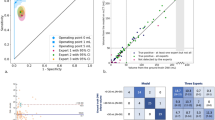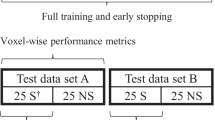Abstract
The hyperdense artery sign (HAS) in cranial non-contrast computed tomography (NCCT) is one of the earliest indicators of an ischemic stroke. We present a deep-learning-based method which incorporates symptomatic information to segment these findings. Our dataset consists of 114 NCCT scans. We include the entire cerebrovascular system, with most occlusions appearing in the M1 or M2 segment of the middle cerebral artery (MCA). Our method is based on the nnUNet framework. We evaluated the inclusion of the information regarding the side of the body on which the stroke symptoms occurred by encoding it in the second input channel. Doing so enhanced nnUNet’s Dice score on the 34 test cases from 0.44 to 0.52. A Dice score of > 0.1, indicating that the thrombus was located correctly, was found in 76 % of the cases. Thereby strong differences in the performance depending on the type of occlusion were observed: for M1 and M2 occlusions a Dice score of > 0.1 was present in 89 % and 73 % of the test cases, whereas the value for the other occlusions was only 25 %. Our study not only confirms the general suitability of the nnUNet for HAS segmentation but also proposes an effective method for incorporating symptom information to enhance the network’s performance. To the best of our knowledge, we are the first to incorporate individual clinical information to enhance HAS segmentation.
Access this chapter
Tax calculation will be finalised at checkout
Purchases are for personal use only
Preview
Unable to display preview. Download preview PDF.
Similar content being viewed by others
References
Mair G, Boyd EV, Chappell FM, Kummer R von, Lindley RI, Sandercock P et al. Sensitivity and specificity of the hyperdense artery sign for arterial obstruction in acute ischemic stroke. Stroke. 2015;46(1):102–7.
Yahav-Dovrat A, Saban M, Merhav G, Lankri I, Abergel E, Eran A et al. Evaluation of artificial intelligence powered identification of large-vessel occlusions in a comprehensive stroke center. AJNR Am J Neuroradiol. 2021;42(2):247–54.
Olive-Gadea M, Crespo C, Granes C, Hernandez-Perez M, Ossa NP de la, Laredo C et al. Deep learning based software to identify large vessel occlusion on noncontrast computed tomography. Stroke. 2020;51(10):3133–7.
Lucas C, Schöttler JJ, Kemmling A, Aulmann LF, Heinrich MP. Automatic detection and segmentation of the acute vessel thrombus in cerebral CT. 2019. Ed. by Handels H, Deserno TM, Maier A, Maier-Hein KH, Palm C, Tolxdorff T:74–9.
Tolhuisen ML, Ponomareva E, Boers AMM, Jansen IGH, Koopman MS, Sales Barros R et al. A convolutional neural network for anterior intra-arterial thrombus detection and segmentation on non-contrast computed tomography of patients with acute ischemic stroke. Appl Sci (Basel). 2020;10(14).
You J, Tsang ACO, Yu PLH, Tsui ELH, Woo PPS, Lui CSM et al. Automated hierarchy evaluation system of large vessel occlusion in acute ischemia stroke. Front Neuroinform. 2020;14.
Duvekot MHC, Es ACGM van, Venema E, Wolff L, Rozeman AD, Moudrous W et al. Accuracy of CTA evaluations in daily clinical practice for large and medium vessel occlusion detection in suspected stroke patients. Eur Stroke Jl. 2021;6,4:357–66.
Popp A, Taubmann O, Thamm F, Ditt H, Maier A, Breininger K. Thrombus detection in non-contrast head CT using graph deep learning. 2022. Ed. by Maier-Hein K, Deserno TM, Handels H, Maier A, Palm C, Tolxdorff T:153–8.
Isensee F, Jaeger PF, Kohl SAA, et al. nnU-Net: a self-configuring method for deep learningbased biomedical image segmentation. Nat Methods. 2021;18:203–11.
Ronneberger O, Fischer P, Brox T. U-Net: convolutional networks for biomedical image segmentation. 2015. Ed. by Navab N, Hornegger J, Wells WM, Frangi AF:234–41.
Author information
Authors and Affiliations
Corresponding author
Editor information
Editors and Affiliations
Rights and permissions
Copyright information
© 2023 Der/die Autor(en), exklusiv lizenziert an Springer Fachmedien Wiesbaden GmbH, ein Teil von Springer Nature
About this paper
Cite this paper
Ertl, A. et al. (2023). Automated Thrombus Segmentation in Stroke NCCT Incorporating Clinical Data. In: Deserno, T.M., Handels, H., Maier, A., Maier-Hein, K., Palm, C., Tolxdorff, T. (eds) Bildverarbeitung für die Medizin 2023. BVM 2023. Informatik aktuell. Springer Vieweg, Wiesbaden. https://doi.org/10.1007/978-3-658-41657-7_33
Download citation
DOI: https://doi.org/10.1007/978-3-658-41657-7_33
Published:
Publisher Name: Springer Vieweg, Wiesbaden
Print ISBN: 978-3-658-41656-0
Online ISBN: 978-3-658-41657-7
eBook Packages: Computer Science and Engineering (German Language)




